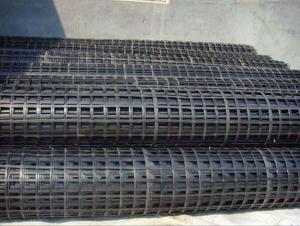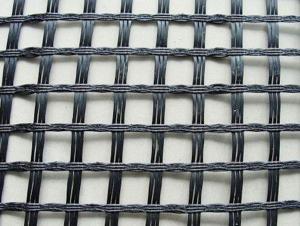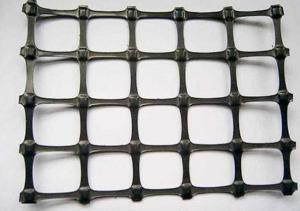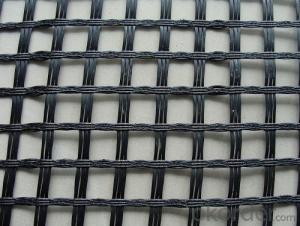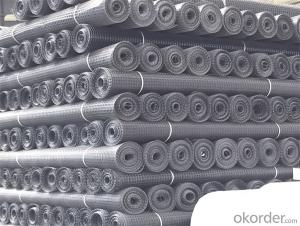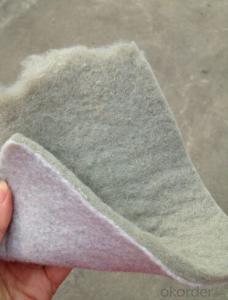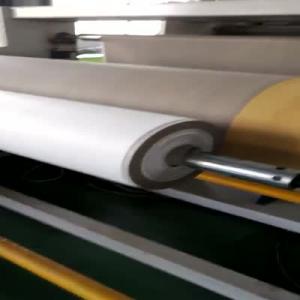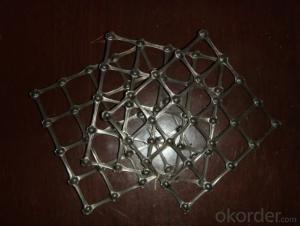Various Types of Geogrids Suppliers from China
- Loading Port:
- Guangzhou
- Payment Terms:
- TT or LC
- Min Order Qty:
- 10 m²
- Supply Capability:
- 9999999 m²/month
OKorder Service Pledge
OKorder Financial Service
You Might Also Like
We provide various types of Geogrids products, and send samples free of charge as required. We are a supplier from China, providing you with the latest products and prices in real time. No matter what kind of material and specification you need, we can meet your needs.
What is a geogrid?
Geogrid is one of the main geosynthetics. Compared with other geosynthetics, it has unique performance and efficacy. It is often used as reinforcement of reinforced soil structures or composite materials. The geogrid is divided into four categories: plastic geogrid, steel plastic geogrid, glass fiber geogrid and polyester warp knitted polyester geogrid. The grid is a two-dimensional grid or three-dimensional grid with a certain height, which is made of polypropylene, polyvinyl chloride and other high molecular polymers through thermoplastic or molding. When used as a civil engineering, it is called a geogrid.
Classification of geogrids
1. Plastic geogrids
The polymer mesh with square or rectangular shape formed by stretching can be divided into unidirectional stretching and biaxial stretching according to the different stretching directions during manufacturing. It is punched on the extruded polymer sheet (raw materials are mostly polypropylene or high-density polyethylene), and then directionally stretched under heating conditions. The unidirectional stretching grid is only made by stretching along the length direction of the plate; The bidirectional stretching grid is made by stretching the unidirectional stretching grid in the direction perpendicular to its length.
2. Mine geogrids
The mining grid is a kind of plastic wall protection net used in coal mine, which is made of polypropylene as the main raw material. After being treated with flame retardant and anti-static technology, the overall structure of the "double anti" plastic net is formed by means of two-way stretching. The product is convenient for construction, low cost, safe and beautiful.
3. Steel plastic geogrids
The steel plastic geogrid is made of high-strength steel wire (or other fibers), after special treatment, polyethylene (PE), and other additives. It is extruded into a composite high-strength tensile strip with rough embossed surface. This single strip is formed by welding its junction points with the fusion welding technology of special strengthening and bonding, which is compiled or clamped at a certain distance longitudinally and transversely. It is a reinforced geogrid.
4. Glass fiber grid
Glass fiber geogrid is a network structure material made of glass fiber with a certain weaving process. In order to protect the glass fiber and improve the overall performance, it is made of a special coating process. The main components of glass fiber are: silicon oxide, an inorganic material, with extremely stable physical and chemical properties, high strength, high modulus, high wear resistance and excellent cold resistance, without long-term creep; Good thermal stability; The mesh structure makes the aggregate locked and restricted; Improve the bearing capacity of asphalt mixture. Because the surface is coated with special modified asphalt, it has dual composite properties, greatly improving the wear resistance and shear capacity of the geogrid.
5. Polyester warp knitted grid
Polyester warp knitted geogrid is made of high-strength polyester fiber. The warp knitted directional structure is adopted, and the warp and weft yarns in the fabric are not bent with each other. The intersection is bound with high-strength fiber filaments to form a firm junction, giving full play to its mechanical properties. The high-strength polyester fiber warp knitted geogrid has high tensile strength, small extension force, large tear resistance strength, small vertical and horizontal strength difference, UV aging resistance, wear resistance, corrosion resistance, light weight, and strong locking force with soil or gravel, It plays a significant role in enhancing the shear resistance of soil and improving the integrity and load capacity of soil.
6. Biaxially stretched plastic geogrids
It is applicable to all kinds of embankment and subgrade reinforcement, slope protection, tunnel wall reinforcement, and permanent bearing foundation reinforcement of large airports, parking lots, wharf freight yards, etc.
7. Uniaxial tensile grid
Unidirectional tensile geogrid is a kind of high-strength geo material made of high molecular polymer as the main raw material, adding certain anti ultraviolet and anti-aging additives, reorienting and arranging the originally scattered chain molecules in a linear state through unidirectional stretching, extruding and pressing them into thin plates and punching regular pore networks, and then stretching them longitudinally. In this process, the polymer becomes a directional linear state and forms a long elliptical reticular integral structure with uniform distribution and high node strength.
Characteristics of geogrid
1. With high strength, low creep and adaptability to various environmental soils, it can fully meet the requirements of high retaining walls in high-grade highways.
2. It can effectively improve the interlocking and occlusion of the reinforced bearing surface, greatly enhance the bearing capacity of the foundation, effectively restrain the lateral displacement of the soil, and enhance the stability of the foundation.
3. Compared with the traditional grid, it has the characteristics of high strength, strong bearing capacity, corrosion resistance, anti-aging, large friction coefficient, uniform hole, convenient construction, long service life, etc.
4. It is more suitable for deep-sea operations and bank reinforcement, and fundamentally solves the technical problems of low strength, poor corrosion resistance, short service life and other technical problems caused by long-term seawater erosion of gabions made of other materials.
5. It can effectively avoid construction damage caused by rolling and damage of machines and tools during construction.
Application field of geogrid
1. It is applicable to subgrade reinforcement and pavement reinforcement of various highways, railways and airports.
2. It is applicable to the reinforcement of permanent bearing foundations such as large parking lots and wharf freight yards.
3. It is applicable to slope protection of railways and highways.
4. Applicable culvert reinforcement.
5. It is applicable to the secondary reinforcement of soil slope after one-way tensile geogrid reinforcement to further strengthen the soil slope and prevent water and soil loss.
6. Reinforcement of mines and tunnels.
Use of geogrid
The geogrid is applicable to the reinforcement of various dykes and embankments, subgrade, slope protection and tunnel wall. Foundation reinforcement for permanent bearing of large airports, parking lots, wharf freight yards, etc.
1. Geogrid is used to increase the bearing capacity of road (ground) foundation and prolong the service life of road (ground) foundation.
2. The geogrid is used to prevent the road (ground) surface from collapsing or cracking, and keep the ground beautiful and tidy.
3. Geogrid is used to facilitate construction, save time and labor, shorten construction period and reduce maintenance costs.
4. The geogrid is used to prevent cracks in the culvert.
5. Geogrid is used to strengthen soil slope and prevent water and soil loss.
6. Geogrid is used to reduce the thickness of cushion and save the cost.
7. Geogrid is used to support the stability and greening environment of grass planting mat on the slope.
8. Geogrid can effectively resist the transmission of seismic force, and plays an important role in strengthening the seismic stiffness, strength and stability of embankment.
- Q:Can geogrids be used in mining and geotechnical applications?
- Yes, geogrids can be used in both mining and geotechnical applications. Geogrids are commonly used in mining to reinforce soil and rock slopes, stabilize excavations, and provide support for haul roads and mine walls. In geotechnical applications, geogrids are used to reinforce soils, increase slope stability, and improve the performance of retaining walls, embankments, and foundations.
- Q:What is the typical length of a geogrid roll?
- The typical length of a geogrid roll can vary depending on the manufacturer and specific application. However, in general, geogrid rolls are commonly available in lengths ranging from 50 to 500 feet.
- Q:What are the long-term performance characteristics of geogrids?
- The long-term performance characteristics of geogrids include factors such as durability, stability, and strength. Geogrids have been proven to maintain their effectiveness over extended periods of time, providing reliable reinforcement and stabilization in various applications. They exhibit excellent resistance to environmental factors like UV radiation, moisture, and chemical exposure, ensuring their longevity. Geogrids also possess high tensile strength, allowing them to withstand heavy loads and distribute stresses effectively. Overall, geogrids offer long-lasting performance, making them a reliable solution for soil reinforcement and erosion control in engineering and construction projects.
- Q:What is the effect of aging on geogrid properties?
- The effect of aging on geogrid properties is that it can lead to a decrease in strength and stiffness, as well as an increase in brittleness and susceptibility to environmental factors such as UV radiation and temperature fluctuations.
- Q:Are geogrids effective in reducing pavement rutting?
- Yes, geogrids are effective in reducing pavement rutting. Geogrids provide reinforcement to the pavement structure, distributing loads and reducing the stress on the pavement surface. This helps to prevent the formation and progression of rutting, resulting in improved pavement performance and longevity.
- Q:What are the durability characteristics of geogrids?
- Geogrids are known for their high durability characteristics. They are typically designed to withstand heavy loads, harsh environmental conditions, and long-term exposure to various elements. Geogrids are made from strong materials such as polyester or polypropylene, which provide excellent tensile strength and resistance against stretching or deformation. Additionally, they have good chemical resistance, making them suitable for use in different soil types and corrosive environments. Overall, geogrids offer long-lasting performance and can provide reliable reinforcement and stabilization for various civil engineering applications.
- Q:Who can say the geogrid, fiberglass mesh and geotextile what is the difference, from the material function, the use of all aspects of speaking, if the answer is good, I add the score
- Geotextile has excellent filtration, drainage, isolation, reinforcement, seepage prevention, protection, light weight, high tensile strength, good permeability, high temperature resistance, anti freezing, anti-aging, corrosion resistance. Common non-woven fabric, consider the use of water inside the polyethylene polypropylene fiber waterproof is also used
- Q:Are geogrids suitable for use in cold climates?
- Yes, geogrids are suitable for use in cold climates. Geogrids are designed to withstand extreme weather conditions, including cold temperatures. They are made from materials that can resist freezing and maintain their structural integrity in cold environments. Additionally, geogrids are used for reinforcement and stabilization purposes in civil engineering projects, such as roads and retaining walls, in various climates worldwide, including cold regions.
- Q:What is the effect of polymer type on geogrid behavior?
- The effect of polymer type on geogrid behavior is significant as it determines the strength, durability, and overall performance of the geogrid. Different polymers have varying tensile strength, elongation characteristics, and resistance to environmental factors such as UV radiation and chemical exposure. Therefore, the choice of polymer type directly impacts the geogrid's ability to provide reinforcement, soil stabilization, and load distribution in geotechnical applications.
- Q:Can geogrids be used in gabion wall construction?
- Yes, geogrids can be used in gabion wall construction. Geogrids are commonly used to reinforce and stabilize soil structures, including gabion walls. They provide additional strength and support to the structure, preventing the movement and deformation of the gabion baskets.
1. Manufacturer Overview |
|
|---|---|
| Location | |
| Year Established | |
| Annual Output Value | |
| Main Markets | |
| Company Certifications | |
2. Manufacturer Certificates |
|
|---|---|
| a) Certification Name | |
| Range | |
| Reference | |
| Validity Period | |
3. Manufacturer Capability |
|
|---|---|
| a)Trade Capacity | |
| Nearest Port | |
| Export Percentage | |
| No.of Employees in Trade Department | |
| Language Spoken: | |
| b)Factory Information | |
| Factory Size: | |
| No. of Production Lines | |
| Contract Manufacturing | |
| Product Price Range | |
Send your message to us
Various Types of Geogrids Suppliers from China
- Loading Port:
- Guangzhou
- Payment Terms:
- TT or LC
- Min Order Qty:
- 10 m²
- Supply Capability:
- 9999999 m²/month
OKorder Service Pledge
OKorder Financial Service
Similar products
New products
Hot products
Hot Searches
Related keywords

